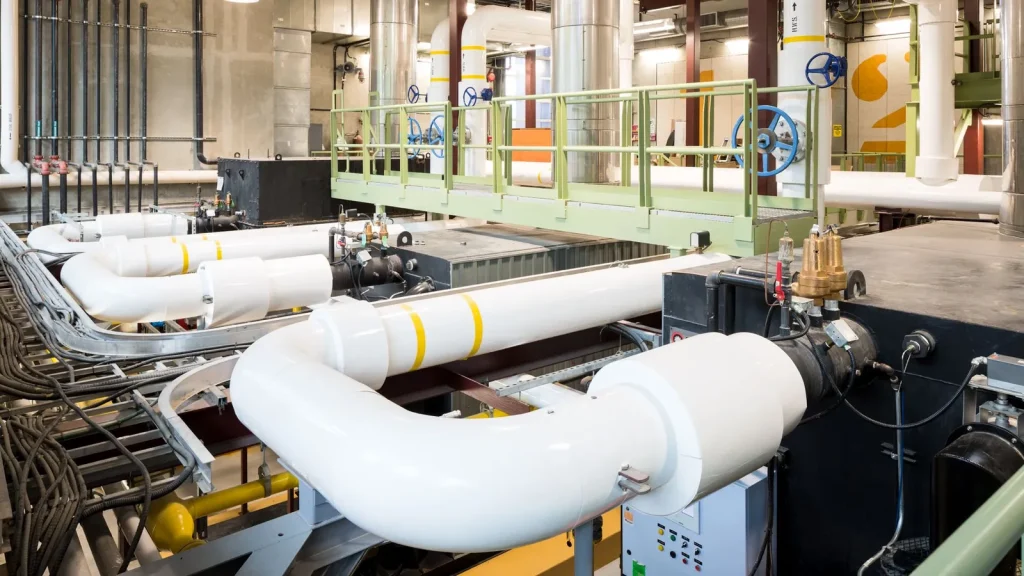In the midst of winter, the streets of Vancouver will be carpeted with a light layer of snow, punctuated by steaming openings where it has already melted. The access holes to the drains below ground are caused by the heat flowing through the city’s sewers, warming up the pavements. “There’s enough heat in the sewerage system to literally heat up neighbourhoods,” remarks Derek Pope, manager of neighbourhood energy for the city of Vancouver, Canada. “That’s what we’ve been doing here in False Creek since 2010.”
The residents of False Creek, a recently redeveloped neighbourhood of Vancouver, on the west coast of Canada, get their energy from a rather unusual renewable source – their sewage wastewater. Increasingly, municipalities around the globe are harnessing this underground form of excess heat as they decarbonise their energy networks.
Residents in the 6,210 apartments in the False Creek neighbourhood get their heat from renewable energy sources, with sewage heat being the largest contributor.
Everything that goes down our drains ends up as sewage water, from what we flush down the toilet to what comes out of our baths and washing machines. Down the pipe, it flows, eventually ending up in a wastewater treatment plant where it is chemically, biologically, and mechanically cleaned and treated, ready to be recirculated back into our homes once again. But the heat that’s generated from the dishwasher or a long, hot shower is generally forgotten about once it washes down the plughole, explains Pope. Instead, it heads underground and straight into the sewer systems, escaping out of vents and melting through the winter snow.

Heat in water is relatively easy to harness once it’s in the sewage system because it’s contained, and no, any heat recovered isn’t going to smell. By comparison, heat in the air quickly escapes out of windows, doors, and roofs. In addition, there’s plenty of hot wastewater to work with. In 2020, experts at the London South Bank University estimated that energy from the UK’s daily 16 billion litres of sewage wastewater could, in theory, provide more than 20 TWh of heat energy annually—enough to provide space heating and hot water to 1.6 million homes. Over in the US, Americans flush an estimated 350 TWh of energy down the drain each year—the equivalent of heating 30 million homes a year.
Tucked under a Vancouver bridge, an energy centre sits on top of the existing sewage pumping station so heat can be captured before sewage reaches the treatment plant. Heat pumps cool down warm sewage that’s around 20 °C (68 °F) in temperature and concentrate that heat to produce scalding hot water, which can be as high as 80 °C (176 °F), Pope explains. “What’s really exciting is that our heat recovery system operates at efficiencies of over 300%, so for every unit of electricity that we put in to run the heat pump, we get over three units of thermal energy or heat out of it.” Sewage is also consistently warm, so heat pumps continue to operate efficiently even on cold wintry days when heat demand is highest, providing a constant source of renewable energy.
In the EU, buildings are responsible for 40% of energy consumption. Heating, cooling, and domestic hot water account for 80% of the energy that we, as citizens, consume. In Vancouver, Pope explains, buildings are responsible for more than 50% of the city’s greenhouse gas emissions because the main way the city heats its buildings and produces hot water is by combusting natural gas. “So utilising waste heat is one of the tools in our toolbelt to transition away from that,” he says. “This is a really good platform for reducing emissions at the neighbourhood scale, especially in areas with dense populations.”
Harnessing sewage heat is a “missed opportunity,” according to Semida Silveira, professor of systems engineering at Cornell University in the US. “There’s a lot of heat in the world that we just throw away. Today, we have a lot of energy inefficiency,” Silveira explains, pointing out that energy efficiency could resolve half of the targets for carbon reductions in the US.
Energy efficiency is overlooked because it’s invisible, Silveira adds. Yet, the International Energy Agency, the global authority for the energy sector, refers to energy efficiency as “the first fuel”—a simple and cost-effective way to reduce demand and strengthen energy security. Excess heat is the world’s largest untapped energy source, according to a 2023 report published by global engineering firm Danfoss. The report highlights how surplus heat produced in the EU—the heat released from transport networks, factories, data centres, sewage systems, and so on—could provide heat for almost the entire region if harnessed effectively.







